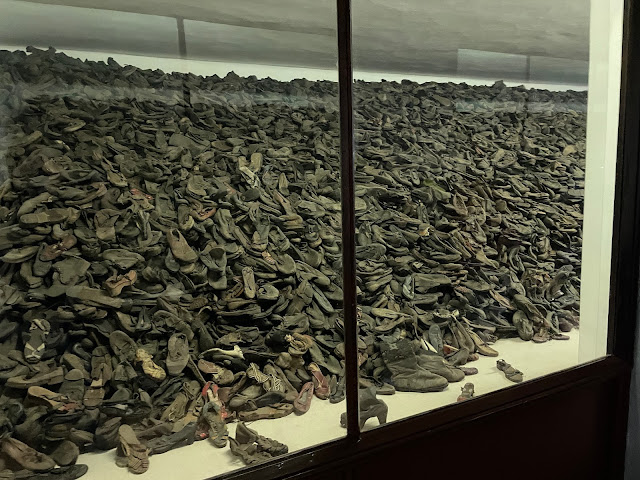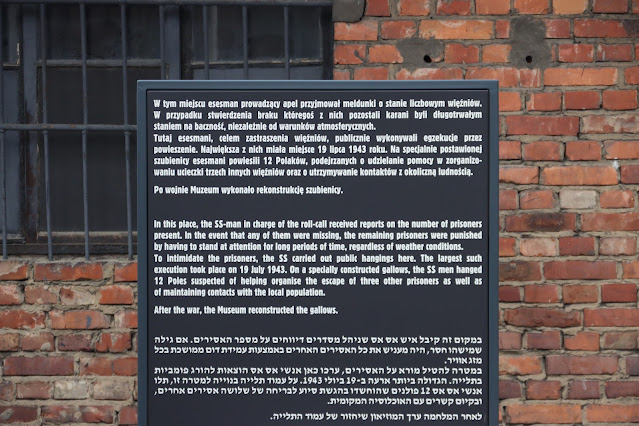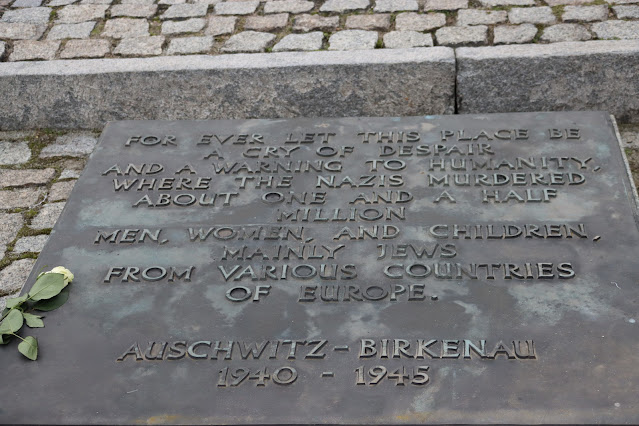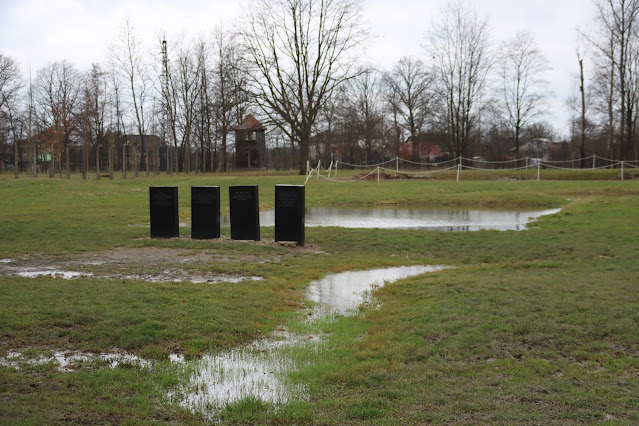Kris and I had both commented on there not quite being the correct term in the English language to explain how we felt about visiting Auschwitz. Exciting, Interesting and other similar terms just don't work when explaining a place with such a dark history and where so much human suffering occurred.
I had previously visited on a rugby trip in 2017 (Blog Link - there may be some repetition between that post and this one) and the tour through the site was informative and tragic in equal measures. I felt that since we were in the area it was important that Kristine and the boys also got to see and experience the camps for themselves. This sort of thing can never be allowed to happen again, and education and remembrance is a big step in preventing it.
I don't usually do trigger warnings for my posts (and if I need to, it's usually due to language or my terrible jokes), but in this case please be warned that Auschwitz and what occurred there is disturbing. I will not have anything graphic, but please be warned.
The area of Poland that houses the camps (there were many offshoots, but the major ones were Auschwitz I and Birkenau) is called Oświęcim. When the Germans captured Poland in World War II they renamed the area Auschwitz.
The Auschwitz I camp was initially an army barracks, but Germany was having a problem housing the Polish political prisoners, so they converted the camp into an prison. The locals were evicted and the area around the camp was 'liquidated'. The first people sent to the camp were Polish criminals and political prisoners from the Sachsenhausen Camp, followed by members of the Polish resistance, Polish academics and other 'undesirables'.
The camp was then turned into a forced labour camp, where the prisoners were forced to work in local factories, support the war effort creating ammunition and weapons and to build the other camps. As the Nazi party progressed with their 'Final Solution' the camp received large numbers of Jewish people from Poland and other captured countries (particularly Hungary). These were joined by the Romani people and a continual influx of political prisoners and criminals, as well as others seen as undesirable such as homosexuals.
The initial focus of the camp was to provide slave labour to aid the war effort, and those providing the labour were expendable. While the planned exterminations didn't start until later, the Germans did not want to waste food or other resources such as coal and wood for heating on the prisoners. Calculations were made to ensure that each prisoner had just enough to keep them going until they were no longer useful. In these cases crematoriums were build to dispose of the dead, those who starved or froze to death, died of disease in the cramped and unhygienic conditions or those that were executed.
Conditions in Auschwitz I were not good, however the buildings had been constructed as a brick barracks and had some levels of warming and protection from the elements. When the camp needed to be expanded, labour was sent to the Birkenau site and stone buildings were created there. As the need for more space increased, the Nazis realized that they could more quickly create stable-like buildings from wooden pre-fabricated sections in a much shorter time. These provided much less protection from the elements but could be constructed quickly and cheaply.
By the time the Jewish people were being sent to the camp, the Nazis began to plan the most efficient way to exterminate them and dispose of the bodies. I think this was the part that I found hardest to take, when visiting the camp - how the whole set up (of Birkenau particularly) was configured to be a 'machine' for disposing as many people in the easiest and quickest manner.
The Jewish people would arrive at Birkenau on a train from their home country, often several days traveling time in cramped conditions with little to no food or water or protection from heat and cold. Many of these people had already been moved several times into Jewish Ghettos, so they were expecting to just be relocated. They packed their essentials and were forced to board the trains. When they arrived at Birkenau they were 'sorted'. Around 20% were sent to the camp, and the others (anyone not seen as fit to work, children, elderly and women) were sent to the extermination area. They were told to leave their belongings on the platform (where they were sorted by the Germans and then sent on to supply the German population) and told that they would be showered and deloused. In order to prevent panic, all of the elements were in place to support this lie. The people were told to leave their clothes on numbered hooks and to remember their number. They were then moved into the gas chamber which was fitted with fake showerheads. The poison, Zyklon B was then dropped through holes in the roof. When heated, it gave off cyanide. The bodies were then removed and taken to the crematorium to be burnt.
As I mentioned, the whole system was set up as a machine to kill and dispose of as many people as possible in a short amount of time. It was this that really stuck with me through the visit.
The tour started in a new concrete building where we passed through a security scanner and then into a waiting room, while we waiting for our tour, the 9:45am English one. Once our guide arrived we were given a headset and started a walk through a long concrete path towards the camp. As we walked in silence, some of the names of those who died in the camp were read out over speakers. We then approached the old administration buildings
Once inside, we watched a short movie about Auschwitz and its history, before heading to the start of the camp and the famous lie "Arbeit Macht Frei" (Work will make you free).
We passed though the double rows of barbed wire and into the main camp. During operation anyone approaching the fences or stepping onto the gravel would have been shot.
Inside the camp gave little indication of the horrific past. The neat rows of brick buildings almost looked like a small village or holiday camp. The original barracks feel remained, until you started to notice small things like the gallows, guard posts, poles for hanging prisoners by their arms and the signs detailing what had occurred:
We then headed into the first exhibit, one providing some history of the camp:
 |
| Map showing where people who were sent to Auschwitz came from |
 |
| Urn containing some of the ashes from those that died at the camp |
We then walked up some well-worn steps to one of the exhibit areas:
 |
| Zyklon B pellets |
 |
| A model of the changing rooms prior to the gas chambers |
 |
| Used canisters of Zyklon B |
 |
| The quote that I feel most sums up my reason for needing to visit the site |
We then headed outside into blocks 1-10 which were originally used to house the female prisoners and then into another exhibit showing some of the things found at the camp when it was liberated. As I mentioned earlier, possessions of the incoming people were confiscated and sent to warehouses to be disinfected (many had been in the insanitary conditions on the trains for several days) and then packed and sent back to Germany to be sold or given to the new waves of German settlers. When the Russians approached the camp, most of the warehouses were burnt down, but some survived, and the items within were captured. The first room housed a huge case containing approximately two tonnes of human hair. This was cut from the prisoners before they were cremated and was used to create fabrics and ropes. Photos were not allowed out of respect for the dead, but later displays were equally as chilling:
 |
| Glasses |
 |
| Prosthetics and crutches |
 |
| Cups, plates and bowls |
 |
| Shoes |
 |
| Suitcases and baskets |
It was a relief to head back outside again, but the guard tower and the warning signs by the fence were a solemn reminder of where we were.
The next exhibit showed examples of the uniforms soldiers had to wear and the colour patches that differentiated the different types of prisoner
Initially, photos were taken of all prisoners when they entered the camp. This was later stopped for several reasons - it was of little help to identify a single prisoner in a camp of tens of thousands, due to malnourished the prisoners soon were unrecognizable from the photo and there were soon so many incoming prisoners, many who would not live for more than a day, that it became impossible to photograph them all. The walls of this hall were lined with photos of some of the prisoners with the dates they arrived and when they died. The numbers are so close together it gives a good image of how deadly the camp was. These were not prisoners who were sent for extermination (photos and records were not kept of the Jewish prisoners), but those assigned to slave labour.
Back outside again, we headed to the punishment cells. The area started with a courtyard between cell blocks 10 and 11, which housed the 'Death Wall' where firing squad executions took place. Cell Block 11 housed the punishment cells, including standing cells where four people would be crammed into a standing room only cell overnight before being let out for work the next day, only to return in the evening. The punishment for talking to another prisoner could be 5 nights in the cells, for dropping heavy pipes (seen as sabotage, the punishment could be up to 5 weeks). Other cells were starvation cells where prisoners could be locked and left to die. Saint Maximilian Kolbe was held in one of these cells before being killed.
Kolbe was a Polish priest who ran a hospital in his monastery during World War II and published religious and anti-Nazi publications. He was arrested in 1939 and released after refusing to sign papers recognizing his German background. The monastery was shut down in February 1941 and Kolbe was sent to Pawiak Prison and then on to Auschwitz. He continued to serve as a priest in the camp and was often beaten by guards. When a prisoner escaped in July 1941 the camp commander selected ten men to be starved to death in the cells in cell block 11. One of the men, Franciszek Gajowniczek, cried out about his wife and children, and so Kolbe volunteered to take his place instead.
Kolbe was sealed in a solitary cell, the same as the other nine men and given no water or food for two weeks. At the end of this time there were only four survivors, including Kolbe. The guards wanted to empty the cells so they gave all of the remaining prisoners lethal injections.
There were no photos allowed of the punishment cells, but wikipedia has a photo of Kolbe's cell and memorial: Photo.
Franciszek Gajowniczek had been sent to Auschwitz from a force labour Gestapo prison after being caught trying to cross into Slovakia from Poland. He survived Auschwitz and was sent on to Sachsenhausen camp in 1944 where he was liberated by the allies after almost 5 and a half years in prison camps. He spread word or Kolbe's sacrifice and became a lay missionary until his death in 1995 at the age of 93. His wife also survived the war and they were reunited, however his sons were killed in a Soviet bombardment just 9 months before his release.
Outside the cells was the Death Wall:
Cell block 10 was used as a medical testing area for Prof. Dr Carl Clauberg who was trying to find a way to mass sterilize women from 'undesirable races'
 |
| Gallows |
Just outside the walls was the gallows where former Camp Commander Rudolf Höss was executed. His house lay to the right of this courtyard where he lived with his wife and 5 children. He even had a playground for his children created that was in sight of the crematorium.
When the camp was about to liberated, the Nazis destroyed all of the crematoria and gas chambers, however the one at Auschwitz I had been too small to keep up with demand so had been converted into a bomb shelter when the newer facility at Birkenau was opened and thus survived the destruction.
We passed through the opening and into the main gas chamber - the holes in the roof were a grim reminder about the use of the Zyklon B. We then passed through the crematorium and out via the storage area.
 |
| Gas chamber |
 |
| Roof hole |
 |
| Incinerator |
 |
| Storage room |
The map below shows the layout of the camp.
A - marks the main gates.
To the left was Sector B1A - the camp for non-Jewish women, followed by B1B - the camp for for men, later converted to another women's camp.
Behind this was EII and EIII which were two of the five gas chambers and crematoria.
To the right of the entrance was BII - made up of the following:
BIIa - Quarantine for men
BIIb - Family camp for Jews from the Theresienstadt Ghetto
BIIc - Transit camp for female Jews (mostly from Hungary)
BIId - Men's camp
BIIe - Family camp for Romani
BIIf - Holding area for sick males
Behind this was
BIIg - The Warehouses for confiscated property (named Canada after the belief that Canada was a rich and prosperous country)
EIV and EV - two of the five gas chambers and crematoria.
The was another section beyond BII, which was named Mexico and was never completed.
 |
| Brick buildings of the Woman's camp |
At the end of the railway tracks was the memorial, made to represent the different burial traditions for all of the nationalities killed at the camp and in all associated languages:
The remains of the gas chambers and crematorium were just alongside the monument, destroyed when the Nazis evacuated the camp as the allies closed in. One of the installations was also destroyed in an uprising of the Sonderkommando using gun powder smuggled in by female workers who worked in the ammunition factories.
 |
| Remains of the changing/undressing area |
 |
| Remains of the gas chamber - marked by the white chain |
and the latrines:
The whole tour took around 3 hours and definitely leaves a lasting impact on the inhumanity that humans can show to others.
I will leave this post with two signs that summed everything up:























































































No comments:
Post a Comment